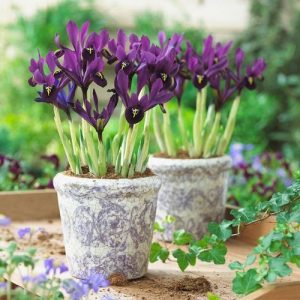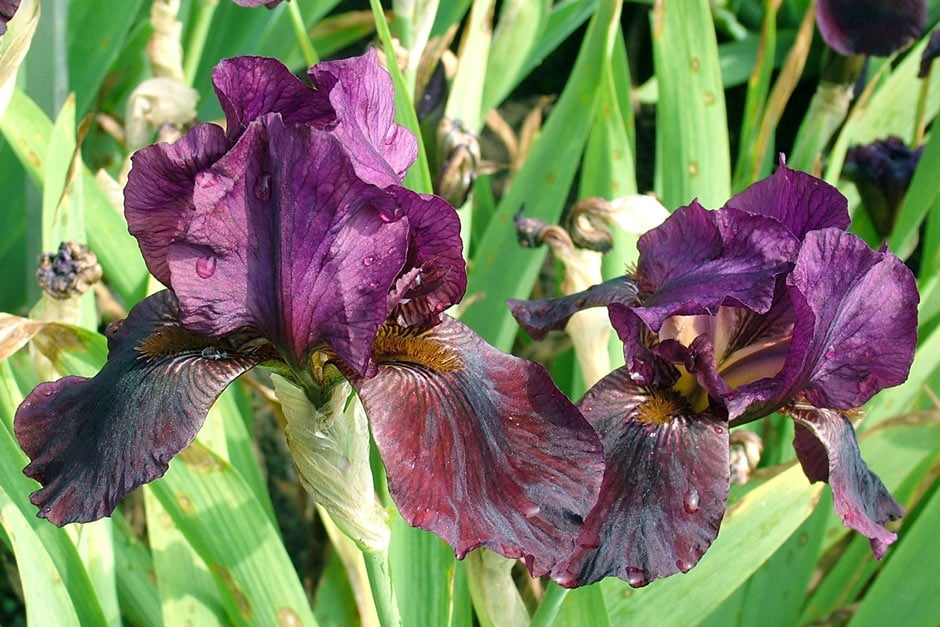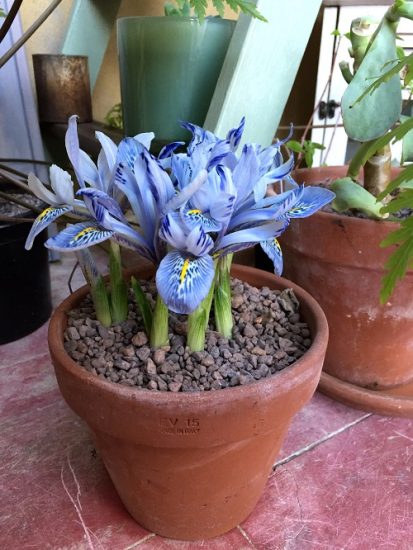Understanding the Life Cycle of Irises
Irises are one of the most popular and beautiful flowers in the world, and understanding their life cycle is essential to appreciating their unique characteristics. The life cycle of an iris consists of several stages, including planting, growth, blooming, and dormancy. Each stage plays a crucial role in the development and blooming of the iris.
The planting stage typically occurs in the fall or early spring, when the soil is cool and moist. During this stage, the iris rhizome is planted in the ground, and the roots begin to grow. As the weather warms up, the iris starts to grow, producing new leaves and stems. This growth stage is critical, as it lays the foundation for the blooming stage.
The blooming stage is the most spectacular part of the iris life cycle. It usually occurs in the late spring and early summer, when the weather is warm and sunny. During this stage, the iris produces beautiful flowers in a wide range of colors, including purple, blue, yellow, and white. The blooming period can last anywhere from a few weeks to several months, depending on the type of iris and growing conditions.
After the blooming stage, the iris enters a period of dormancy, during which the plant rests and recharges its energy. This stage is essential, as it allows the iris to conserve energy and prepare for the next growing season. By understanding the life cycle of irises, gardeners can better appreciate the beauty and complexity of these amazing flowers.
So, how long do irises bloom? The answer depends on the type of iris and growing conditions. On average, irises bloom for around 2-4 weeks, but some varieties can bloom for up to 6 weeks or more. By providing optimal growing conditions and care, gardeners can encourage their irises to bloom for longer periods and enjoy their beauty throughout the growing season.
Factors Affecting Iris Blooming Periods
While irises are known for their stunning blooms, the length of time they bloom can vary significantly depending on several factors. Understanding these factors can help gardeners optimize growing conditions and enjoy longer blooming periods. So, how long do irises bloom? The answer depends on a combination of climate, soil quality, watering, and fertilization.
Climate plays a significant role in determining the blooming period of irises. In general, irises bloom for longer periods in cooler climates with moderate temperatures. In warmer climates, the blooming period may be shorter, as the heat can cause the flowers to fade more quickly. Gardeners in warmer climates can try providing some shade for their irises to prolong the blooming period.
Soil quality is another critical factor affecting iris blooming periods. Irises prefer well-draining soil that is rich in organic matter. Soil with poor drainage or lacking essential nutrients can lead to shorter blooming periods. Gardeners can improve soil quality by adding compost or well-rotted manure.
Watering is also essential for optimal iris blooming. Irises need consistent moisture, especially during the blooming period. However, overwatering can lead to root rot and shorter blooming periods. Gardeners should aim to provide about 1-2 inches of water per week, either through rainfall or irrigation.
Fertilization can also impact iris blooming periods. Irises benefit from regular fertilization, especially during the growing season. A balanced fertilizer with a ratio of 10-10-10 (nitrogen-phosphorus-potassium) can promote healthy growth and longer blooming periods. Gardeners should avoid overfertilizing, as this can lead to weak growth and shorter blooming periods.
By understanding and optimizing these factors, gardeners can enjoy longer blooming periods and more vibrant flowers. Whether you’re a seasoned gardener or just starting out, with the right conditions and care, you can enjoy the beauty of irises for weeks to come.
How Long Do Different Types of Irises Bloom?
Irises are a diverse group of flowers, with over 300 species and countless hybrids. While they share some similarities, different types of irises have distinct blooming periods. Understanding these differences can help gardeners plan and enjoy their iris blooms.
Bearded irises are one of the most common types of irises and are known for their long, drooping petals and distinctive “beard” of hairs on the falls. They typically bloom in late spring, around May or June, and the blooming period can last anywhere from 2-4 weeks. Some popular varieties of bearded irises include ‘Fortune’ and ‘Beverly Sills’.
Beardless irises, on the other hand, lack the characteristic “beard” of hairs on the falls. They tend to bloom earlier than bearded irises, often in late April or early May, and the blooming period can last around 2-3 weeks. Some popular varieties of beardless irises include ‘Siberian’ and ‘Japanese’ irises.
Japanese irises are a type of beardless iris that is known for its exotic, orchid-like blooms. They typically bloom in late spring, around May or June, and the blooming period can last anywhere from 2-4 weeks. Some popular varieties of Japanese irises include ‘Kuma’ and ‘Higo’.
Other types of irises, such as Louisiana and Pacific Coast irises, have slightly different blooming periods. Louisiana irises tend to bloom in late spring, around May or June, while Pacific Coast irises bloom in late summer, around August or September.
So, how long do irises bloom? The answer depends on the type of iris and growing conditions. By understanding the different blooming periods of various iris species, gardeners can plan and enjoy their iris blooms throughout the growing season.
What to Expect During the Blooming Season
As the blooming season approaches, gardeners eagerly anticipate the vibrant colors and delicate beauty of their irises. But what can you expect during this time? The duration of blooms, frequency of blooming, and notable characteristics of the flowers all vary depending on the type of iris and growing conditions.
In general, irises bloom for around 2-4 weeks, although some varieties may bloom for longer or shorter periods. During this time, the flowers will typically bloom in succession, with new blooms opening as older ones fade. This process is called “staggered blooming,” and it allows gardeners to enjoy a prolonged display of color.
The frequency of blooming also varies depending on the type of iris. Some irises, such as bearded irises, tend to bloom more frequently than others, such as Japanese irises. In general, irises will bloom more frequently in cooler climates with moderate temperatures.
One of the most notable characteristics of irises is their unique flower shape. Irises have three petals and three sepals, which are often referred to as “falls” and “standards.” The falls are the drooping petals, while the standards are the upright petals. This unique shape gives irises their distinctive appearance and makes them a popular choice for gardeners.
During the blooming season, gardeners can also expect to see a range of colors and patterns on their irises. From pure whites and yellows to vibrant purples and blues, irises come in a stunning array of colors. Some varieties also feature intricate patterns, such as stripes or spots, which add to their beauty.
So, how long do irises bloom? The answer depends on the type of iris and growing conditions. By understanding what to expect during the blooming season, gardeners can better appreciate the beauty and uniqueness of their irises.
How to Extend the Blooming Period of Your Irises
While irises are known for their beautiful blooms, the blooming period can be relatively short. However, with proper care and attention, gardeners can extend the blooming period of their irises and enjoy their beauty for longer. So, how long do irises bloom? By following these tips, you can encourage your irises to bloom for longer periods.
Deadheading is one of the most effective ways to extend the blooming period of irises. By removing the spent blooms, you can encourage the plant to produce more flowers. Simply snip off the dead blooms at the base of the stem, and the plant will respond by producing new flowers.
Fertilizing is another way to promote longer blooming periods in irises. Use a balanced fertilizer that is high in phosphorus, as this will encourage blooming. Apply the fertilizer in the spring, when the plant is actively growing, and again in the summer, after the blooming period has ended.
Providing optimal growing conditions is also essential for extending the blooming period of irises. Make sure the plant is receiving enough sunlight, water, and nutrients. Irises prefer well-draining soil and full sun to partial shade. By providing the right conditions, you can encourage your irises to bloom for longer periods.
Another way to extend the blooming period of irises is to divide and replant the rhizomes. This will encourage the plant to produce new growth and more flowers. Simply dig up the rhizomes in the fall, divide them, and replant them in the spring.
Finally, consider using a technique called “staggered planting” to extend the blooming period of your irises. By planting irises at different times, you can create a staggered blooming effect, where the plants bloom at different times. This will extend the overall blooming period and provide a longer display of color.
By following these tips, you can extend the blooming period of your irises and enjoy their beauty for longer. Whether you’re a seasoned gardener or just starting out, with the right care and attention, you can encourage your irises to bloom for weeks to come.
Common Challenges and Solutions for Iris Bloomers
While irises are relatively low-maintenance flowers, they can still be affected by various challenges that can impact their blooming period. In this section, we’ll discuss some common issues that may affect iris blooming and provide solutions and troubleshooting tips to help readers overcome these challenges.
Pests are one of the most common challenges that can affect iris blooming. Aphids, whiteflies, and spider mites can all feed on iris plants, causing damage to the leaves and flowers. To control pests, use neem oil or insecticidal soap, and make sure to inspect your plants regularly for signs of infestation.
Diseases are another common challenge that can impact iris blooming. Iris plants are susceptible to fungal diseases such as iris leaf spot and iris root rot. To prevent diseases, make sure to provide good air circulation around your plants, and avoid overwatering. If you do notice signs of disease, treat your plants with a fungicide and remove any infected leaves or stems.
Environmental stressors can also impact iris blooming. Extreme temperatures, drought, and excessive rainfall can all cause stress to iris plants, leading to reduced blooming. To mitigate environmental stressors, make sure to provide your iris plants with optimal growing conditions, including full sun to partial shade and well-draining soil.
Soil quality can also impact iris blooming. Irises prefer well-draining soil that is rich in organic matter. If your soil is heavy clay or sandy, consider amending it with compost or well-rotted manure. This will help to improve soil structure and fertility, leading to healthier plants and more blooms.
Finally, iris plants can be affected by nutrient deficiencies, particularly nitrogen and phosphorus. To ensure that your iris plants are receiving the nutrients they need, fertilize them regularly with a balanced fertilizer. This will help to promote healthy growth and blooming.
By understanding and addressing these common challenges, readers can help to ensure that their iris plants bloom for longer periods and remain healthy and thriving. Whether you’re a seasoned gardener or just starting out, with the right care and attention, you can enjoy the beauty of irises all season long.
Creating a Stunning Iris Display: Tips and Tricks
Irises are one of the most beautiful and versatile flowers in the garden, and with a little creativity, you can create a stunning display that showcases their beauty. In this section, we’ll share some tips and tricks for showcasing irises in the garden, including companion planting, container gardening, and creative ways to display blooms.
Companion planting is a great way to create a stunning iris display. By planting irises with other flowers that complement their colors and textures, you can create a beautiful and harmonious display. Some good companion plants for irises include daylilies, coneflowers, and black-eyed susans.
Container gardening is another great way to showcase irises. By planting irises in containers, you can create a beautiful and portable display that can be moved around the garden or patio. Make sure to use a large enough container to accommodate the iris rhizomes, and provide good drainage to prevent waterlogged soil.
Creative ways to display blooms are also a great way to showcase irises. Consider using a trellis or obelisk to support tall iris stems, or create a beautiful bouquet of fresh-cut irises. You can also use irises in floral arrangements, or press them to create beautiful and delicate art.
When creating a stunning iris display, consider the color and texture of the irises. Irises come in a wide range of colors, from pure whites and yellows to vibrant purples and blues. Consider combining different colors and textures to create a beautiful and harmonious display.
Finally, don’t forget to consider the blooming period of your irises when creating a display. Irises typically bloom in the spring, but some varieties can bloom in the summer or fall. Consider planting a mix of early, mid-season, and late-blooming irises to create a display that lasts all season long.
By following these tips and tricks, you can create a stunning iris display that showcases the beauty of these amazing flowers. Whether you’re a seasoned gardener or just starting out, with a little creativity and planning, you can enjoy the beauty of irises all season long.
Conclusion: Enjoying the Beauty of Irises All Season Long
In conclusion, irises are a beautiful and versatile flower that can add color and interest to any garden or landscape. By understanding the different stages of an iris’s life cycle, including planting, growth, blooming, and dormancy, gardeners can better appreciate the beauty of these flowers and enjoy their blooms for longer periods.
Throughout this article, we’ve discussed the various factors that influence the length of time irises bloom, including climate, soil quality, watering, and fertilization. We’ve also provided tips on how to optimize these factors for longer blooming periods, such as deadheading, fertilizing, and providing optimal growing conditions.
We’ve also explored the different types of irises, including bearded, beardless, and Japanese irises, and highlighted any notable differences in blooming times between these types. Additionally, we’ve shared ideas for showcasing irises in the garden, including companion planting, container gardening, and creative ways to display blooms.
By following the tips and advice outlined in this article, gardeners can enjoy the beauty of irises all season long. Whether you’re a seasoned gardener or just starting out, with a little creativity and planning, you can create a stunning iris display that showcases the beauty of these amazing flowers.
So, how long do irises bloom? The answer depends on the type of iris, growing conditions, and care. But with the right knowledge and techniques, you can enjoy the beauty of irises for weeks to come. Happy gardening!








